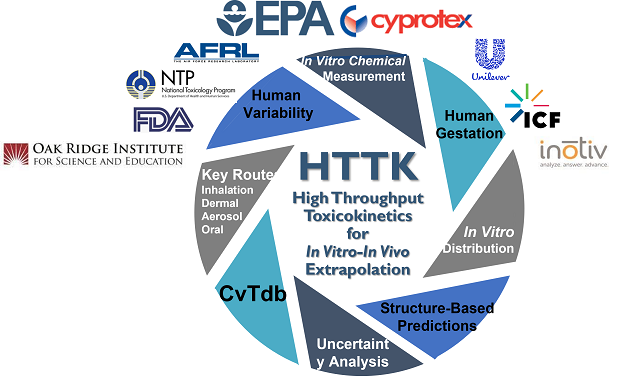High-Throughput Toxicokinetics.

R Package "httk"
This R package provides data and models for prediction toxicokinetics (chemical absorption, distribution, metabolism, and excretion by the body). The models are design to be parameterized with chemical-specific in vitro (animal free) measurements. The predictions can be used for traditional dosimetry as well as in vivo-in vitro extrapolation (IVIVE) of in vitro bioactivity testing data (for example, ToxCast). See Breen et al. (2021) for a recent review.
This repository is for reporting bugs and contributing enhancements. Installable files, documentation, and other information can be obtained from https://cran.r-project.org/package=httk.
Description
Pre-made models that can be rapidly tailored to various chemicals and species using chemical-specific in vitro data and physiological information. These tools allow incorporation of chemical toxicokinetics ("TK") and in vitro-in vivo extrapolation ("IVIVE") into bioinformatics, as described by Pearce et al. (2017). Chemical-specific in vitro data characterizing toxicokinetics have been obtained from relatively high-throughput experiments. The chemical-independent ("generic") physiologically-based ("PBTK") and empirical (for example, one compartment) "TK" models included here can be parameterized with in vitro data or in silico predictions which are provided for thousands of chemicals, multiple exposure routes, and various species. High throughput toxicokinetics ("HTTK") is the combination of in vitro data and generic models. We establish the expected accuracy of HTTK for chemicals without in vivo data through statistical evaluation of HTTK predictions for chemicals where in vivo data do exist. The models are systems of ordinary differential equations that are developed in MCSim and solved using compiled (C-based) code for speed. A Monte Carlo sampler is included for simulating human biological variability (Ring et al., 2017) and propagating parameter uncertainty (Wambaugh et al., 2019). Empirically calibrated methods are included for predicting tissue:plasma partition coefficients and volume of distribution (Pearce et al., 2017). These functions and data provide a set of tools for using IVIVE to convert concentrations from high-throughput screening experiments (for example, Tox21, ToxCast) to real-world exposures via reverse dosimetry (also known as "RTK") (Wetmore et al., 2015).
Getting Started
For an introduction to R, see Irizarry (2022) "Introduction to Data Science": http://rafalab.dfci.harvard.edu/dsbook/getting-started.html
For an introduction to toxicokinetics, with examples in "httk", see Ring (2021) in the "TAME Toolkit": https://uncsrp.github.io/Data-Analysis-Training-Modules/toxicokinetic-modeling.html
Dependencies
- Users will need the freely available R statistical computing language: https://www.r-project.org/
- Users will likely want a development environment like RStudio: https://posit.co/download/rstudio-desktop/
- If you get the message "Error in library(X) : there is no package called 'X'" then you will need to install that package:
install.packages("X")
Or, if using RStudio, look for ‘Install Packages’ under ‘Tools’ tab.
- Note that R does not recognize fancy versions of quotation marks ‘,$~$’,$~$“, or$~$”. If you are cutting and pasting from software like Word or Outlook you may need to replace the quotation marks that curve toward each other with ones typed by the keyboard.
Installing R package "httk"
Adapted from Breen et al. (2021)
- Getting Started with R Package httk from the R command line
install.packages("httk")
Load the HTTK data, models, and functions
library(httk)
- Check what version you are using
packageVersion("httk")
Examples
- List all CAS numbers for all chemicals with sufficient data to run httk
get_cheminfo()
- List all information (If median.only=FALSE you will get medians, lower 95th, and upper 95th for Fup, plus p-value for Clint, separated by commans, when those statistics are available. Older data only have means for Clint and Fup.):
get_cheminfo(info = "all", median.only=TRUE)
- Is a chemical with a specified CAS number available?
"80-05-7" %in% get_cheminfo()
- All data on chemicals A, B, C (You need to specify the names instead of "A","B","C"...)
subset(get_cheminfo(info = "all"), Compound %in% c("A","B","C"))
- Administrated equivalent dose (mg/kg BW/day) to produce 0.1 uM plasma concentration, 0.95 quantile, for a specified CAS number and species
calc_mc_oral_equiv(0.1,chem.cas = "34256-82-1",species = "human")
calc_mc_oral_equiv(0.1,chem.cas = "99-71-8", species = "human")
- Calculate the mean, AUC, and peak concentrations for a simulated study (28-day daily dose, by default) for a specified CAS number and species
calc_tkstats(chem.cas = "34256-82-1",species = "rat")
calc_tkstats(chem.cas = "962-58-3", species = "rat")
- Using the PBTK solver for a specified chem name
solve_pbtk(chem.name = "bisphenol a", plots = TRUE)
- Create data set, my_data, for all data on chemicals A, B, C, in R
my_data <- subset(get_cheminfo(info = "all"), Compound %in% c("A","B","C"))
- Export data set, my_data, from R to csv file called my_data.csv in the current working directory
write.csv(my_data, file = "my_data.csv")
User Notes
- When using the CAS number as a unique chemical identifier with 'httk' functions it is best to type these numbers directly (i.e. by hand) into the console, script, Rmarkdown, etc. to avoid unnecessary error messages. Webpages, word documents, and other sources of these CAS numbers may use a different character encoding that does not match those used in the 'httk' data sources.
Help
- Getting help with R Package httk
help(httk)
- You can go straight to the index:
help(package = httk)
- List all vignettes for httk
vignette(package = "httk")
- Displays the vignette for a specified vignette
vignette("IntroToHTTK")
Authors
Principal Investigator
John Wambaugh [[email protected]]
Lead Software Engineer
Sarah Davidson [[email protected]]
Model Authors and Function Developers
Robert Pearce, Caroline Ring [[email protected]], Greg Honda [[email protected]], Mark Sfeir, Matt Linakis [[email protected]], and Dustin Kapraun [[email protected]]
Bug-Fixes Vignette edits, and Parameter Values
Miyuki Breen [[email protected]], Shannon Bell [[email protected]], Xiaoqing Chang [[email protected]], Todor Antonijevic [[email protected]], Jimena Davis, Elaina Kenyon [[email protected]] James Sluka [[email protected]],
Nisha Sipes [[email protected]], and Barbara Wetmore [[email protected]]
Statistical Expertise
Woodrow Setzer [[email protected]]
License
License: GPL-3 https://www.gnu.org/licenses/gpl-3.0.en.html.